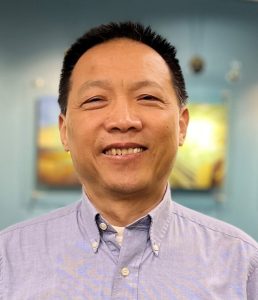ASCE Fellow and bridge specialist David Liu joins IMEG

David Liu, PhD, PE, SE, recently joined IMEG as a senior structural engineer specialist with the firm’s civil group. He has over 25 years of experience in structural design and plan preparation of steel I-girder, steel box girder, steel truss, prestressed concrete girder and post-tensioned bridges, retaining and noise walls, and railroad bridges. He is also an ASCE Fellow, a prestigious honor held by just 3% of ASCE members. David discusses his career and the field of bridge engineering in the following Q&A.
Q. Tell us about your career and where it has taken you.
A. I earned my bachelor’s and master’s degrees in structural engineering at South China University of Technology, Guangzhou, China, and later earned a doctorate of structural engineering (as well as a doctorate in philosophy) from Clarkson University in Potsdam, N.Y. In addition to working in the U.S., I have worked in the UAE, Canada, Indonesia, and China. I developed a passion for bridge engineering early on and have worked on bridge projects for over 25 years.
Q. What are some of your most notable or memorable projects?
A. Several projects come to mind, including serving as senior structural engineer for Lion’s Gate Bridge, Vancouver, B.C., for which I performed 3-D nonlinear analysis of the 2,778-foot-long suspension bridge for both existing and proposed conditions. In the Midwest, I was the Engineer of Record for the Peoria Street bridge over I-290 and CTA in Chicago—the first precast deck panel bridge in Illinois with UHPC (ultra-high-performance concrete) joints. I also designed Minnesota’s first haunched steel box girder bridge, Oregon’s first continuous deck bulb tee girder bridge, Iowa’s first stabbed H-pile foundation to support integral abutments, and was senior engineer for the Christopher S. Bond Bridge in Kansas City, a self-anchored suspension bridge.
Q. What is the biggest issue in relation to the nation’s bridges?
A. Countless bridges are in dire need of improvements or replacement. Adequate funding for these improvements has been lacking for years. The recent federal infrastructure bill—which includes $110 billion for roads, bridges, and major infrastructure—is a good start, but it won’t be enough. Sustained increases in infrastructure funding is needed for the long term.
Q. What added value can you and IMEG provide to agencies with bridge projects on the horizon?
A. In addition to having the technical expertise that we bring to any project anywhere, our local presence in offices across the country ensures we have the knowledge and understanding of local and state codes and requirements and are familiar with the transportation agencies and their personnel.
Q. You have been very prolific in sharing your knowledge and expertise through technical papers and conference presentations. What has that entailed?
A. I have written 300 technical papers, several of which have been published, presented, or submitted to ASCE Journals, ASCE periodicals, conferences, and seminars. I also have peer reviewed technical papers for ASCE.
Q. What developments or changes do you foresee in bridge design?
A. AI (artificial intelligence) applications in bridge design will certainly become more common in the future. I also expect to see expanded use of ultra-high-performance concrete (UHPC) on bridge and other transportation market projects. According to the Federal Highway Administration, UHPC provides enhanced durability compared to conventional and high-performance concretes, making it an ideal material to consider for extending the lifespan of bridge and highway infrastructure.
Contact David Liu at David.Liu@imegcorp.com.







